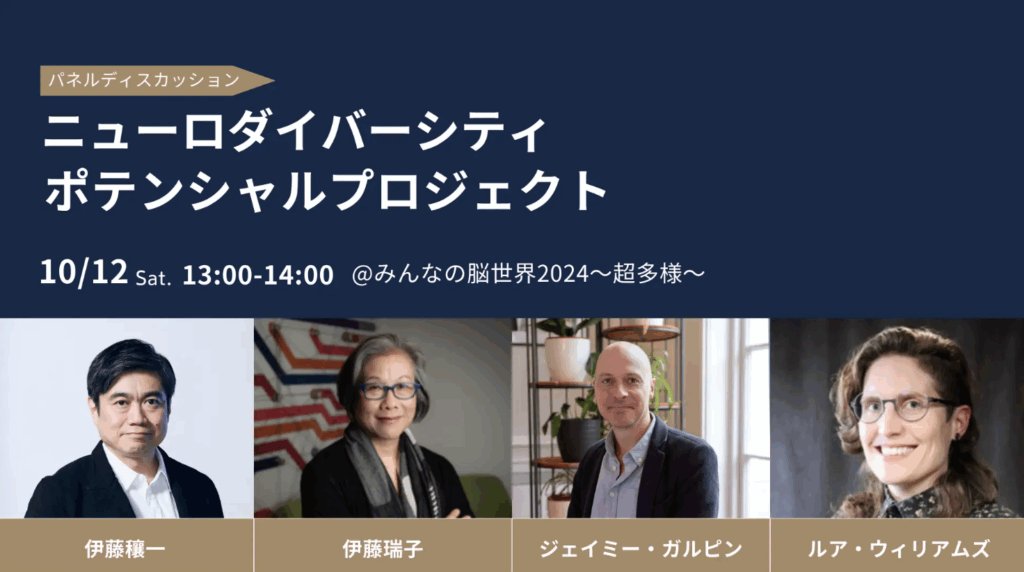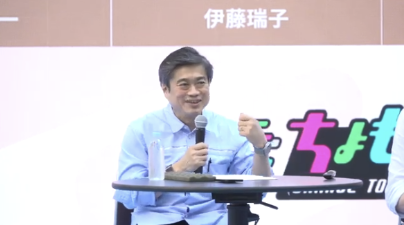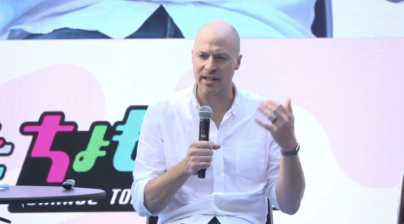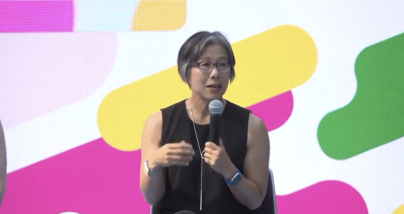The Future of Neurodiversity: A Society that Maximizes Individual Potential – Neurodiversity Potential Project
4/18/25

Interesting Future 2024 a little further ahead” (Chomoro 2024) was held on October 12 and 13, 2024, at Takeshiba, Minato-ku, Tokyo. There, the panel discussion “Neurodiversity Potential Project” was held as part of the “Brain World 2024 for Everyone – Super Diversity.
What kind of technology and what kind of social design are needed to maximize the potential of neurodiversified people? In the panel discussion, experts from Japan, the U.S., and the U.K. actively exchanged opinions on the topics of technology, education, and the state of society.
<Panelists/Speakers>
- Joichi Ito: Co-founder and Director, Digital Garage, Inc.
- Jamie Galpin: Developmental Psychologist/Special Networks Co Founder
- Lua Williams: Assistant Professor, UX Design Program, Purdue University
- Mizuko Ito: Professor, University of California, Irvine / Director, Connected Learning Lab
- Nanako Ishido : Director, B Lab
Project to view neurodiversity as a “potential”.
The panel discussion began with opening remarks by Nanako Ishido (▲Picture 1▲), Director of B Lab.

Ishido: “We at “Chomoro” have adopted neurodiversity as one of our themes from 2023 and are promoting a project to deepen understanding of diversity focusing on brain and neural diversity and to realize a neurodiverse society. Today, we have invited leading researchers in the field of neurodiversity from overseas to participate in a panel discussion moderated by Joichi Ito (▲Picture 2▲), co-founder and director of Digital Garage, Inc. and president of Chiba Institute of Technology, as well as co-founder of the Neurodiversity School in Tokyo. The panel discussion will be moderated by Joichi Ito (▲Picture 2▲), co-founder of Neurodiversity School in Tokyo. We hope that this panel discussion will deepen your understanding of the Neurodiversity Potential Project.

Mr. Ito: “I would like to introduce three of today’s special panelists. First, we have Dr. Jamie Galpin, developmental psychologist and Co-Founder of Special Networks. Next is Lua Williams, Assistant Professor in the UX Design Program and Computer Graphics Technology at Purdue University, and then my sister, Professor Mizuko Ito from the University of California, Irvine. My research focuses on youth digital culture from the perspectives of cultural anthropology and learning science.
Today, we will introduce the “Neurodiversity Potential Project” through a panel discussion. The characteristics of people with neurodiversity, such as autism, ADHD, and dyslexia, have until now been viewed as disabilities and treated as challenges to be overcome. However, with the advancement of neurodiversity research, these characteristics have recently been reviewed as strengths and potentials, and the idea of amplifying (strengthening as characteristics) rather than compensating for them as weaknesses has been attracting attention.
However, in order to maximize the potential of neurodiversity people based on this idea, it is essential to create an environment where their strengths (potential) can be utilized. Therefore, experts from Japan and the U.S., including Chiba Institute of Technology, Neurodiversity School in Tokyo, Ms. Ishido’s B Lab, and Prof. Mizuko Ito of the University of California, Irvine, are collaborating to explore innovative approaches to creating an environment and solving problems. This is the “Neurodiversity Potential Project.
One of the key points of the neurodiversity movement is that society needs to change, meaning that society must also adapt to the diversity of individuals.
One more thing. The current standardized Japanese education system does not develop the strengths and likes of individuals, but rather compensates for what they cannot do or what they do not like, with the goal of passing as many standardized exams as possible. Recently, however, technology has allowed us to compensate for our weaknesses to some extent, and in the age of AI, the world would be more vibrant if there were a more diverse group of people. The Neurodiversity Potential Project also aims to develop innovative technologies that will enable neurodiverse people to reach their full potential.
Regardless of neurodiversity
Everyone feels differently about events
Mr. Ito: “One of the key words when thinking about neurodiversity is ‘balance. How to balance the needs that are common to many people with the diverse needs of neurodiversity people; how to be fair by balancing the support needed by the majority with the support needed for a few people; how to support the authority and what healthy people want to do. This means things like how to support and balance the diverse brains of people, including people with disabilities, while supporting them. I would like to start with these issues first,” he said.
Dr. Galpin: “First of all, what we need to understand is that everyone has a different way of feeling and perceiving experiences of certain events, etc., regardless of whether they consider themselves healthy or neurodiverse people. (▲Photo 3▲)

Each of you in this venue is experiencing the same space in a very different way. Experiences are processed based on one’s previous experiences. Even if the same experience is input, how that experience is analyzed and processed is different for each person. Therefore, I feel that it is important for everyone to first understand that each person’s experiences are diverse and different, and that the experiences that are processed based on those experiences are also different for each person. In other words, it is important for everyone to understand how diverse people, including people with disabilities, really feel and what they really want.
We use our senses to process inputs. In doing so, the input is analyzed and recognized by various stimuli, as well as by the prediction or expectation of what the input will make us do. For example, if I show you an illustration and ask you what it looks like, you will get a variety of answers. However, if you first tell them that a mermaid swims in front of a round window to observe the underwater world, and then show them the illustration, they will see it as such.
In other words, we can see an object differently simply by adding words to it. Therefore, our experience is the result of our interpretation and processing of an event, based on our previous experiences and some other logic. Due to differences in our experiences and the way we process them, each person has a different experience of the same space.
The important point here is not what experiences are good or bad, but that ‘every experience is different. This is an important point. We are speculating in uncertainty. Although each person’s experience is diverse, the motivation to understand “what is happening right now” is common to all of us. In order to live in an uncertain world, when an event is input, we predict, analyze, and process it based on our previous experiences, which is what experience is, and this act is common to all of us.
So why do we all feel anxious about an uncertain world and why do we try to predict, analyze, and process inputs? It is because our brains work to balance the energies that keep us alive. When uncertainty occurs, there is an imbalance of energy between the outside environment and the environment inside the body. There is diversity in each person, diversity in experience, diversity in body, and then there is a reasonable balance of energy for each person,” he said.
There is no such thing as a ‘normal human being.
Asst. Prof. Williams: “I have Autism, ADHD, and a variety of other neurodiversity, and I sometimes experience a variety of struggles in my daily life. When making judgments about someone as to whether they are healthy or not, we sometimes check to see ‘how far away’ they are from the average person, the normal person, but the truth is that no one is where they are considered ‘normal,’ that is, where they are ‘normal. This does not mean that all of you are disabled, nor does it mean that none of you are disabled. Since there is no average person in the middle, we believe the point is that what is useful for the disabled may be useful for any person. (▲Photo 4▲)

Until now, research and development of technology for people with disabilities has been directed toward considering people with disabilities from a social and behavioral perspective and using technology to fix what is out of the ordinary. When considering people with disabilities, it is important to consider not only the social and behavioral aspects, but also society’s perception of people with disabilities. I believe that technology can be used here as well. Technology can be used as a tool to support recognition.
However, if we think only in terms of the three axes of social, behavioral, and cognitive, that is still not enough. In a very complex and diverse landscape, different technologies can support different people in different contexts. It is better to think about technology from that perspective.
For example, a person on the beach, a person in the mountains, a person in the forest – the support needed for each person is all different. If we think of technology as a tool for support, in order to support someone, we have to listen and understand the context and environment in which that person is. Then it becomes important to know how to support them.
As Dr. Jamie Galpin explained earlier, even when people are in the same place, there are differences in the way they feel and the reality they perceive. Therefore, you cannot understand a person’s context and environment by ‘just looking’ at that person. You have to ask the person properly. You may think you are in the forest, but your friend may see you in the mountains. Depending on the difference, there are different types of technology and support that you can use.
How will the education practiced for ordinary people change in the future?
Mr. Ito: “Thank you very much. Next, I would like to discuss education and learning. Education up to now has been, so to speak, to make people standardized and normal, and to nurture them from there. You could say that technology was utilized in this process. In contrast, from the perspective of neurodiversity, I think there is a slightly different way of thinking about it.”
Prof. Ito: “My research has been focused on learning and technology, and neurodiversity has not been my specialty. Recently, however, I have learned a lot from Dr. Jamie Galpin, Asst. Prof. Lua Williams, and other neurodiversity researchers, and I am very interested in their research. (▲Photo 5▲)

My research is based on the concept of ‘connected learning,’ or learning through connection. Connected learning is a simple concept that takes individual interests and identities with children as a starting point to naturally develop their strengths and learn important lessons for society.
Connection learning is based on the idea that everyone wants to learn about something that interests them. The interest can be anime, railroads, or music, and it can be diverse, but everyone has their own interest, identity, and motivation to learn that comes from it. Whether the interest itself is animation, trains, or music, everyone has diversity, but the basic enjoyment of learning and the pleasure of learning with others who share that interest is a feeling that everyone has.
I have been conducting research on how to naturally connect individual interests, identities, and cultural backgrounds to learning based on the concept of connected learning, rather than the standardized learning practiced in regular schools, while each child has different identities and experiences due to various differences in culture, socioeconomic status, and other factors. We have been conducting research to naturally connect individual interests, identities, and cultural backgrounds to learning based on the concept of connected learning.
In addition, I have become very interested in neurodiversity. In recent pedagogy, there is a movement toward having children learn naturally what they are interested in and can develop their strengths in, rather than forcing them to learn what they cannot do. Although this is still a new concept, we would like to continue our research in this direction, including the aspect of neurodiversity.
For example, in the case of studying mathematics, the conventional way of thinking required everyone to study the same thing. This is not the case with the concept of “kizuna no kakari” (connection learning). If a child is interested in Thomas the Locomotive, we would like to embed a device that allows him or her to naturally learn mathematics in the story, so that each child can naturally learn from his or her own interests and identity. With the use of recent technology and AI, it is now easy to do so. We hope that this kind of thinking will expand the possibilities for everyone’s creativity.
Asst. Prof. Williams: “From the perspective of correcting the disabilities that different people have, it sounds like what each person is perceiving and experiencing is also different, so what some people are perceiving and experiencing is wrong and therefore needs to be corrected. In other words, it seems to me that we are trying to create a standardized person by eliminating as many differences as possible between people. When this happens, the person may deny themselves, dislike themselves, and lose their self-esteem. The result will be that many such children will grow up.
If you try to fix a child with a diverse brain as much as possible, even though each individual is diverse, the child’s behavior will resemble that of a normal person, but it will not appear to those around him or her that the child is acting from his or her true feelings. Many children kill themselves, hide themselves, and act like normal people. According to one survey, the suicide attempt rate for autistic people is 49%, and the percentage of people who have thought about suicide is over 70%. Self-esteem is lowered.
After all, if we can recognize the reality of each individual, what kind of environment they are in, and allow them to choose for themselves the support they need for the reality they are aware of, and be provided with the technology to do so, we will be able to nurture independent people. If we raise our children in such a way that they can live confidently within their own perceived reality, then when they become adults, they will be able to see “diverse adults” acting “in diverse realities” and “in diverse behaviors. Then the diverse adults, and the children who see those diverse behaviors, will be able to live in that diversity with more and more confidence. I expect that this will become a positive loop.”
Dr. Galpin: “Earlier Asst. Prof. Lua talked about various support technologies. I believe that supportive technologies that are important and necessary for some people are technologies that, if applied properly, can be supportive for everyone. For example, ramps on stairs and steps are not only essential for people in wheelchairs, but they can be useful in many ways for people other than those in wheelchairs. They are useful for people on crutches and for people pushing carts. In the universal design concept, always look for stairs and steps to install ramps. It helps everyone, both those who can use stairs and those who cannot.
For example, in mental health, medication may be prescribed for a diagnosed illness. However, the symptoms and causes of depression are different for each individual. Some people argue that the very idea of “diagnosis” is not good, as it puts people into the category of depression, even though each person is different. The transdiagnostic approach is to think that support beyond the diagnosis is necessary and that such support is possible.
For example, it is common for two people to be diagnosed with depression in the same way, but have very different reactions to the same medication or therapy. Researchers observe people with different diagnoses and reactions and analyze them from the perspective of what they have in common despite their different diagnoses. For example, different people may have different diagnoses, such as depression, but have anxiety as the root cause. By supporting these commonalities, we can go beyond the diagnosis and help multiple patients get well at the same time.
It is also efficient to support this commonality. In common, uncertainty makes everyone anxious. When we reduce uncertainty, everyone is happy. For example, eliminating uncertainty in schools supports children, but there are few people who are not helped by knowing what is going to happen, i.e., having uncertainty removed. It is for everyone’s benefit.
In the same way, if you think about the relationship between your internal sense of perception, which is the internal sensation of your body, such as your heartbeat, breathing, and digestion, and your emotional sensations, you will be more positive if you can understand the regulation of your heartbeat and breathing. If you can properly recognize in yourself that your heartbeat and breathing are faster, you will be able to control your feelings of anxiety by doing so. Support for understanding the sense of inner acceptance would also be helpful for any child.
Each person’s body reacts differently when he or she is happy. However, I believe that by being curious about, understanding, and properly managing these reactions, it can lead to stability for many people. How to support this sense of internal receptivity in the body from a transdiagnostic perspective is a major theme of my research.
Developing the Potential of Neurodiversity
What Technology Should Be
Mr. Ito: “Thank you very much. Next, I would like to discuss technology. I would like to hear your opinions on how technology can be used to support people with neurodiversity, and conversely, what can be done to negatively affect it.
Asst. Prof. Williams: “I have done a lot of research on technology for people with disabilities. There are many different ideas and arguments about whether technology is good or not. What I want to emphasize in light of these discussions is that in many cases, children with disabilities do not have the authority to choose the technology they utilize. Children are hooked on tablets because they choose to use them. It is important that they have the right to choose and use the technology.
Prof. Ito: “In connected learning, which I have been studying for a long time, I have found that technologies that are good for able-bodied children can also be applied to children with autism and neurodiversity.
As Lua Williams mentioned earlier, for able-bodied children, the right to make their own choices, to be independent, and to customize their lives will lead to learning. On the other hand, it is also important for children with brain diversity and autism. For healthy children, customization is often within our predictable range, even when customization is necessary and implemented. In contrast, diverse neurodiverse children are in some cases in a reality they do not understand. I think it is especially important to give them choices about what technology to use and how to use it.
Japanese Pokemon and other anime characters are popular worldwide. The stories are deep, varied, selective and customizable, and research has shown that they are very good tools for building relationships with children. When we create such programs, we attract a large number of autistic children whose brains are statistically diverse. It appears to be particularly well-liked by those children.”
Asst. Prof. Williams: “Looking back on our own lives, I think we actively use tools for scheduling and communicating with friends, but we would not want to actively use tools for reporting our appointments and managing our schedules at work, even if the technology is similar. However, you would not want to use tools for reporting your schedule and managing your schedule at work, even if they are similar technologies. I think this is the difference between technology that you choose and technology that is forced on you. I think it is very important to know who is selecting the technology.
Dr. Galpin: “In thinking about that environment, children need to have a say, the right to choose, and independence. They need all three, and I think technology can properly support that.”
Mr. Ito: “Thank you very much. If an able-bodied person develops a technology only from the viewpoint of an able-bodied person, it may be a technology that is not actually needed by neurodiversified people. The effectiveness of the same technology may differ between technology that is provided to people who want to use it and need it, and technology that is imposed by schools, companies, and other organizations.
After all, the important thing is to think carefully about “what you really need,” based on the premise that each person is different. When I attended a conference once, someone was giving a lecture about a jacket that enables hearing-impaired people to hear speech through vibration. So many attendees, including myself, asked the hearing-impaired artist who was with me, ‘Have you seen it? It’s very good. But the artist said, “I don’t want to hear the voices of able-bodied people anymore. I want to talk. Why do you keep trying to develop technology that makes me hear what I don’t want to hear?
In other words, none of them asked the artists and audiences what kind of technology they wanted or what kind of technology they needed. The question was “What kind of technology do you want?
I think discussions like today’s are very meaningful and important in a world where there is actually a lot of imposed technology. It is important that those who have the funding and technical skills to research and develop technology and those who have disabilities and differences talk to each other and listen to what is really needed, and start from there.
Even with the same technology, the meaning of what you want to use and what you are forced to use are completely different. Social design is also very important. Many universities have already started to conduct research. Researchers can communicate with each other and methods are available, so we at the Chiba Institute of Technology are thinking of creating a new graduate school and making it a theme of ours. We hope that these discussions will be one of the opportunities for collaboration involving academia, industry, and education,” he said.


